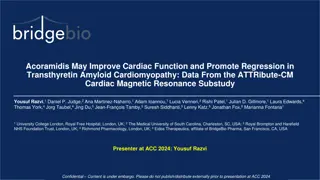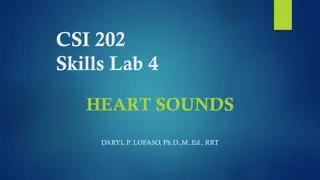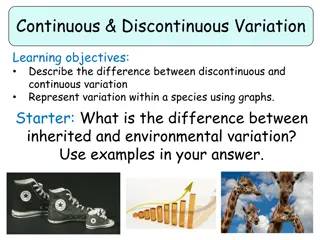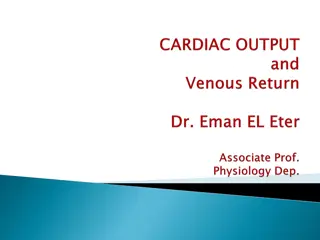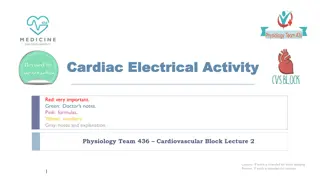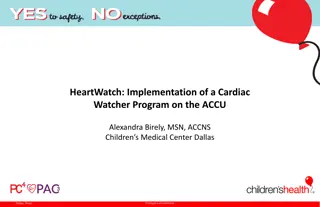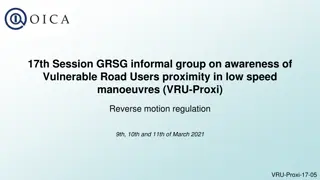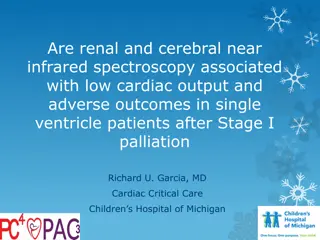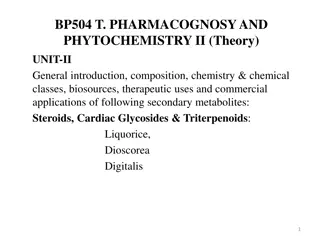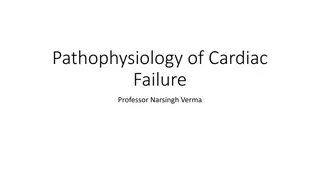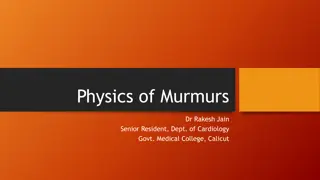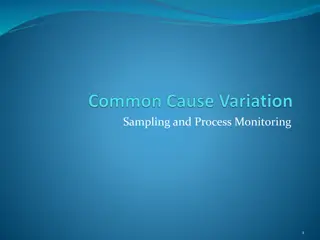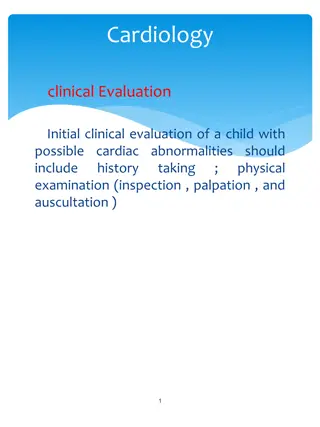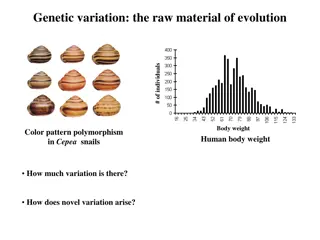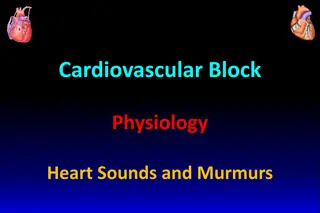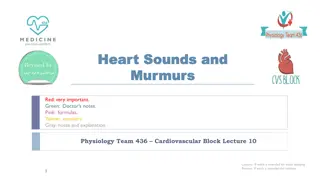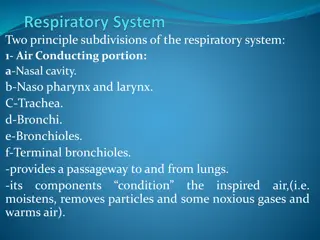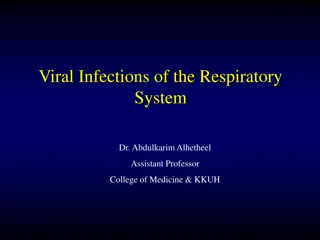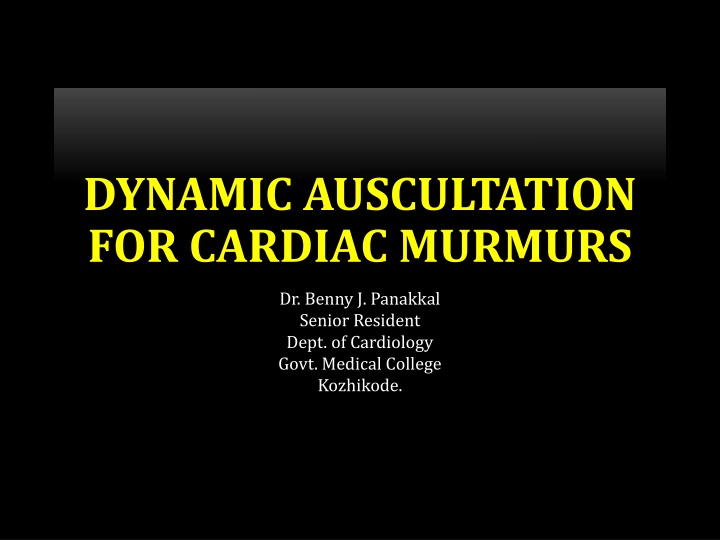
Dynamic Auscultation for Cardiac Murmurs: Respiratory Variation & Manoeuvres
In this comprehensive presentation by Dr. Benny J. Panakkal, explore the application of dynamic auscultation for cardiac murmurs. Learn about respiratory variation, Muller and Valsalva maneuvers, inspiration effects on heart sounds, and more. Gain insights into different pathologies affecting heart sounds with practical illustrations and explanations.
Download Presentation

Please find below an Image/Link to download the presentation.
The content on the website is provided AS IS for your information and personal use only. It may not be sold, licensed, or shared on other websites without obtaining consent from the author. If you encounter any issues during the download, it is possible that the publisher has removed the file from their server.
You are allowed to download the files provided on this website for personal or commercial use, subject to the condition that they are used lawfully. All files are the property of their respective owners.
The content on the website is provided AS IS for your information and personal use only. It may not be sold, licensed, or shared on other websites without obtaining consent from the author.
E N D
Presentation Transcript
DYNAMIC AUSCULTATION FOR CARDIAC MURMURS Dr. Benny J. Panakkal Senior Resident Dept. of Cardiology Govt. Medical College Kozhikode.
1. RESPIRATORY VARIATION MULLER MANEUVER VALSALVA MANEUVER PRESENTATION OUTLINE 2. SUSTAINED HANDGRIP 3. POSTURAL CHANGES 4. POST VPC / LONG DIASTOLE OF AF 5. PHARMACOLOGICAL MANEUVERS AMYL NITRITE 11-03-2025 2
RESPIRATORY VARIATION 11-03-2025 3
INSPIRATION 1. Normal inspiration dilatation of pulmonary vascular system and venous return to right side of the heart frank-starling mechanism stroke volume RESPIRATORY VARIATION 2. stroke volume also aided by RV outflow impedance 3. Respiratory variation most marked in sitting and standing position 4. Normal or slightly deep breaths allowed. Very deep respirations Partial Valsalva phenomenon 11-03-2025 4
MULLER MANOEUVRE Methods to elicit Close nose with finger in mouth suck the finger with closed glottis Suck on a mouthpiece hooked to mercury manometer for 10 secs at 40-50 mm Hg negative pressure RESPIRATORY VARIATION Increases right heart flow for longer periods compared to respiration All right sided events with inspiration Except pulmonary ejection click 11-03-2025 5
PULMONARY EJECTION CLICK In inspiration RV preload RV end-diastolic pressures pulmonary valve may partially open up just BEFORE systole overall excursion of the pulmonary valve reduced intensity of ejection sound RESPIRATORY VARIATION PAH RV end-diastolic pressures still remain considerably lower than pulmonary artery diastolic pressures, hence the ejection click variation with respiration is absent Different pathologies different variations Pulmonary valve stenosis and idiopathic dilatation of pulmonary arteries ejection click varies with respiration PAH ejection click does not vary with respiration 11-03-2025 6
EXPIRATION Normal expiration lung volume pulmonary venous flow Therefore, left sided murmurs are loudest during expiration and diminish or remain unchanged during inspiration RESPIRATORY VARIATION THE SECOND HEART SOUND DURING RESPIRATION Widening of normal splitting of second heart sound (wide variable splitting) 1. Delayed electrical activation RBBB 2. Prolonged mechanical systole Pul. Stenosis 3. Prolonged hangout interval Idiopathic dilatation of Pulmonary Artery 11-03-2025 7
THE SECOND HEART SOUND DURING RESPIRATION Wide fixed splitting (ASD) 1. Pulmonary impedance is almost minimum to incorporate the pulmonary blood flow inspiration therefore does not cause a further fall in impedance and hence does not cause a further separation of A2 and P2 thereby appearing fixed RESPIRATORY VARIATION Paradoxical splitting of S2 Inherently delayed A2 component due to 1. Delayed electrical activation LBBB 2. Delayed mechanical systole Aortic Stenosis 11-03-2025 8
VALSALVA MANOEUVRE Forced exhalation against a closed glottis As if to have a bowel movement Examiner places a hand on the patient s abdomen to make sure the abdominal muscles are tightened RESPIRATORY VARIATION Alternative method blow into a mercury manometer to maintain a pressure of 40 mmHg 1. Usually continued for around 10 secs 2. If done for > 10 secs, chance of syncope Make sure patient isn t blowing using his cheeks false negatives 11-03-2025 9
PHASES Phase I Strain phase blood squeezed from the lung into the left heart transient in SBP Subsequent in right sided cardiac output left sided cardiac output SBP RESPIRATORY VARIATION Sympathetic stimulation with vasoconstriction and tachycardia Phase II Release of strain right sided blood flow followed gradually by left sided blood flow Right sided murmurs in 1-4 cardiac cycles, left sided by 5-10 cardiac cycles Overshoot of SBP due to previous sympathetic stimulation and vasoconstriction reflex bradycardia 11-03-2025 10
ABNORMAL PHASES If absent overshoot suspect Mild LV dysfunction Autonomic failure RESPIRATORY VARIATION If absent in SBP during strain phase Overt CCF Large L R shunt Transient in coronary blood contraindicated in k/c/o myocardial ischemia or recent infarction 11-03-2025 11
EFFECTS All murmurs, both left and right sided in intensity : except 1. Mitral Valve Prolapse (MVP) LV volume earlier leaflet prolapse intensity and duration of murmur Manoeuvre is unreliable not to be completely relied upon variable responses obtained RESPIRATORY VARIATION 2. Hypertrophic obstructive cardiomyopathy (HOCM) Dynamic obstruction with a in LV volume Highly specific but not very sensitive sign 11-03-2025 12
MITRAL STENOSIS AN EXCEPTION FOR VALSALVA MANOEUVRE Valsalva causes an overall in left sided cardiac output works towards ing the intensity of MS murmur RESPIRATORY VARIATION Ensuing tachycardia incomplete emptying of the LA backlogging and elevated LA pressures in LA-LV gradient works towards ing the intensity of MS murmur Above to mechanisms cancel each other out hence, no change in MS murmur 11-03-2025 13
VALSALVA FOR DIFFERENTIATING A2 AND P2 During strain phase both A2 and P2 are diminished in intensity During release phase P2 first returns to baseline intensity, followed later by A2 RESPIRATORY VARIATION 11-03-2025 14
SUSTAINED HANDGRIP 11-03-2025 15
METHOD 1. Squeeze examiner s fingers with one or both hands 2. Calibrated dynamometer SUSTAINED HANDGRIP Duration Minimum of 60-90 secs must elapse before a significant change in BP and heart rate is observed Avoid concomitant Valsalva manoeuvre Parameter Handgrip Dynamic exercise Heart rate Cardiac output SBP 11-03-2025 16
a.Systemic vascular resistance Changes only if strain applied is > 50% of patient s maximum. LV filling pressures Augmented LV S3 and S4 EFFECTS Systemic vascular resistance Changes only if strain applied is > 50% of patient s maximum. Further, LV filling pressures AND Augmented LV S3 and S4 seen in patients with LV dysfunction apart from in heartrate, CO and SBP. SUSTAINED HANDGRIP Murmurs that are augmented 1. AR 2. MR 3. MVP (MR) 4. VSD 11-03-2025 17
EFFECTS Murmurs that are reduced in intensity or show no change 1. AS 2. HOCM variable response hence not a very useful manoeuvre in this condition SUSTAINED HANDGRIP Reason for variable response in HOCM 1. SVR tends to the gradient CANCEL EACH OTHER OUT 2. Tachycardia tends to the gradient 11-03-2025 18
EFFECTS IN rheumatic mitral stenosis Tachycardia incomplete LA emptying LA filling pressures LA-LV gradient augmentation of murmur SUSTAINED HANDGRIP Helps distinguish between OS and S3/pericardial knock OS moves closer to A2 S3/pericardial knock does not change position 11-03-2025 19
POSTURAL CHANGES 11-03-2025 20
PHYSIOLOGY Supine to standing changes similar to Valsalva manoeuvre Standing Valsalva Squatting opposite of Valsalva The quicker the change in posture, the more dramatic the change in murmur POSTURAL CHANGES Squatting 1. Compression of femoral arteries mean aortic pressure afterload 2. Compression of leg veins and abdomen venous return preload For those unable to perform squatting passive flexion of both legs towards abdomen in supine position mimics squatting mediated hemodynamic changes. 11-03-2025 21
EFFECTS Standing all cardiac murmurs in intensity Except HOCM and MVP Changes similar to Valsalva on standing POSTURAL CHANGES Postural change from supine to standing venous pooling stroke volume reflex tachycardia and in SVR Require an intact and functioning autonomic nervous system to manifest effects on murmurs. in chronic CCF, these manoeuvres are not useful. So are the physical changes in these maneuvers. Respiration Valsalva Handgrip Postural change 11-03-2025 22
POST-VPC / LONG DIASTOLE IN AF No active patient cooperation required Intactness of ANS not required 11-03-2025 23
PHYSIOLOGY Effects observed POST-VPC / LONG DIASTOLE IN AF 1. preload frank-starlings law contractility 2. aortic diastolic pressure 11-03-2025 24
EFFECTS Aortic stenosis (valvular, supravalvular and discrete subvalvular) 1. forward flow 2. gradient between LV and aorta POST-VPC / LONG DIASTOLE IN AF 3. intensity of the murmur HOCM 1. Variable effects due to opposing influences of ( preload) and ( contractility with aortic impedance) 2. Also, associated MR murmur may interfere with intensity estimation 11-03-2025 25
EFFECTS Mitral regurgitation No change in intensity preload and contractility is compensated by afterload, thereby preferentially pushing the extra volume of blood into the aorta rather than the LA POST-VPC / LONG DIASTOLE IN AF There still is an regurgitant flow into the LA in the isovolumetric contraction phase of LV However, the regurgitant flow in the later part of systole to LA is Why TR murmur does not follow the same principles of MR? afterload after a VPC is a feature specific for the systemic circulation Further, the pulmonary circulation is already a very low impedance circulation, hence any further drop in the RV afterload would be clinically subtle, it at all present. 11-03-2025 26
PHARMACOLOGICAL MANEUVERS AMYL NITRITE INHALATION 11-03-2025 27
PHYSIOLOGY Method Hold ampoule in a tissue wrap near the patient s nose and mouth Break ampoule and ask patient to take 3 deep breaths AMYL NITRITE INHALATION Actions Onset within 15 secs Duration 30 secs BP returns to normal in 1-2 minutes Reflex tachycardia occurs by 30-60 secs after inhalation 11-03-2025 28
EFFECTS Initially, no increase in stroke volume afterload AMYL NITRITE INHALATION Initial in preload Reflex tachycardia in stroke volume 11-03-2025 29
EFFECTS All LVOT systolic murmurs in intensity 1. Aortic stenosis Valvular Supravalvular Discrete subvalvular AMYL NITRITE INHALATION 2. HOCM 3. Aortic regurgitation murmurs softens 4. MR murmur Decreases in intensity CONTRAST WITH POST VPC STATE 11-03-2025 30
CONGENITAL HEART DISEASE Murmur intensity decreases because the systemic vascular resistance the flow through the systemic circulation and the flow through the shunt VSD PDA AMYL NITRITE INHALATION in pulmonary flow murmur due to in R L shunt TOF Differentiating PS with intact ventricular septum vs. TOF with PS PS murmur increases while the latter decreases Differentiating between valvular MS vs. Austin Flint murmur MDM of valvular MS increases while the latter decreases 11-03-2025 31
THANK YOU 11-03-2025 32

